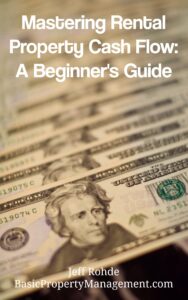Learn About Real Estate

Are you a contrarian investor, able to see opportunity while others just follow the herd? Then Rental Property Management in a Market Crash is for you!
While history doesn’t always repeat itself, it often rhymes. Looking at the current events, there are some parallels being drawn with the lead-up to the Global Financial Crisis (GFC) of 2007-09.
One of the striking similarities is the impact both crises have had on the global economy. The GFC led to a severe recession, and today, we are witnessing economic disruption on a similar, if not larger scale. This disruption has created uncertainty, a key factor shared by both crises once they emerged.
Notably, the financial crisis began within the housing sector, marked by inflated property prices and easy credit conditions. Comparatively, today’s real estate market has been experiencing a significant surge in home prices, fueled in part by low interest rates and limited supply, causing some economists to worry about the possibility of another bubble.
The GFC began with a boom in the housing market. Easy credit conditions led to increased borrowing, allowing many people to buy homes they couldn’t afford. This resulted in a housing bubble, where house prices were inflated far beyond their true value. However, like all bubbles, this one eventually burst. When the bubble popped, millions of homeowners found themselves “underwater,” owing more on their mortgages than their homes were worth.
When homeowners faced foreclosure, their reactions varied widely. Some tried to fight the process, engaging in legal battles to keep their homes. Others, overwhelmed by the situation, simply walked away. In extreme cases, homeowners stripped their homes of valuable materials, such as copper wiring and appliances, either to sell for cash or out of spite towards the lenders who were taking their homes.
Foreclosures also led to numerous abandoned pets. Unable to afford their care or find housing that would accommodate them, many homeowners left their pets behind when they moved out. Animal shelters reported a significant increase in the number of abandoned pets during the height of the foreclosure crisis.
The emotional toll of foreclosure was equally severe. Many homeowners reported feelings of shame, embarrassment, and helplessness. It was not uncommon for people to hide their situation from friends and family, further isolating themselves during an already difficult time.
In some cases, foreclosed properties were left vacant for months or even years, becoming symbols of the financial crisis and contributing to neighborhood blight. These “zombie homes” could attract crime, lower property values, and create safety hazards.
However, the market eventually began to recover. By 2012, home prices started to rise again, and by 2016, the national median home price had returned to its pre-recession levels. The recovery wasn’t uniform across the country—some areas recovered faster than others—but overall, the trend was positive.
The GFC highlighted the importance of sound investment strategies and the need for caution when market conditions seem too good to be true. In the years since the crash, many investors have adopted more conservative approaches, focusing on long-term stability over short-term gains.
Whether you’re a seasoned real estate investor or just starting, understanding the impact of the GFC on the US housing market is crucial. It provides valuable insights into the dynamics of the market during a downturn and underscores the importance of being prepared for all eventualities. By learning from the past, you can make more informed decisions and build a more resilient investment portfolio.
In this book we’ll dive deeper into strategies for investing in and managing rental properties during a recession, drawing on lessons learned from the GFC. We’ll explore how to navigate market downturns, protect your investments, and position yourself for success when the market rebounds.
- Amazon as an ebook
- Books2Read for Apple, Barnes & Noble, Kobo, Scribed, and 8 more sellers with both eBook and paperback options available
- Payhip as a downloadable PDF

Are you a property manager looking to increase your bottom line? Or perhaps an investor wanting to make money in real estate but don’t know where to start? If so, this is the guide for you!
Written by Jeff Rohde – a Certified Commercial Investment Member (CCIM) with over 30 years of experience in the industry. This comprehensive book covers everything from how to choose the right property management fee, getting paid what you’re owed through collecting leasing fees, increasing your bottom line by charging for maintenance and project management services and much more!
- Amazon
- Books2Read for Apple, Barnes & Noble, Kobo, Scribed, and 8 more sellers with both eBook and paperback options available
- Payhip as a downloadable PDF

Unlock the Secrets to Mastering Rental Property Cash Flow with This Beginner’s Guide!
Are you ready to dive into the world of rental property investing but unsure where to begin? Imagine having a roadmap that not only simplifies the process but also maximizes your profits. In “Mastering Rental Property Cash Flow: A Beginner’s Guide,” you’ll find just that – an expert blueprint to help you navigate the world of rental properties.
In this quick-read ebook, you’ll discover:
- Rental Property Cash Flow Basics: Grasp the fundamentals of cash flow, its importance in real estate investing, and how to accurately calculate it for long-term success.
- The Art of Choosing the Right Investment Property: Uncover the significance of location, learn to spot under-valued properties, and analyze potential cash flow to ensure you’re making a smart investment.
- Smart Financing Strategies for Maximum Cash Flow: Explore creative financing options, group investing, and fractional investing to leverage your investment and boost your cash flow.
- Optimizing Your Rental Income: Master setting competitive rental rates, reducing vacancy rates, and adding value-added services to attract and retain high-quality tenants.
- Minimizing Expenses to Boost Cash Flow: Implement cost-saving measures, establish a regular maintenance and repair schedule, and employ effective property management techniques to minimize expenses and maximize profits.
- Tax Strategies to Maximize Your Cash Flow: Understand the tax benefits of rental properties, utilize depreciation and deductions, and work with professionals to legally save on taxes and increase your cash flow.
By following this comprehensive guide, you’ll be well-equipped to build a thriving rental property portfolio and create a steady stream of income. Don’t miss your chance to unlock the secrets of mastering rental property cash flow.
- Amazon
- Books2Read for Apple, Barnes & Noble, Kobo, Scribed, and 8 more sellers with both eBook and paperback options available
- Payhip as a downloadable PDF

The Premium Edition of How To Find & Keep Great Tenants also includes the bonus book Investment Real Estate Analysis: A Case Study.
Here’s an excerpt from How To Find & Keep Great Tenants:
If real estate is all about “Location, location, location”, then finding & keeping tenants and managing the rental house to maximize its value is all about Marketing.
Over 25 years ago I received my real estate license, and from day one I was amazed at the number of businesses that feed off of the real estate broker!
Admittedly I’ve always been a little skeptical of the real estate industry, its associations and numerous designations, and the myriad of services that spring up to provide services to the industry.
The biggest mistake real estate marketers make is to provide too much up-front information about the house for rent. This happens because they do not have a specific objective for their marketing initiatives.
With advertising and marketing, it’s important to closely track the ratio between dollars spent and income received as a direct result of each marketing channel.
From Investment Real Estate Analysis: A Case Study:
It’s a well kept secret in buying investment real estate that you are almost always buying the seller’s problem.
Think about it this way: If a property has good tenants, is for the most part trouble-free and is cash flowing, why on earth would the current owner want to sell? Sure, there are some legitimate reasons, but even those innocent sounding excuses for selling can hide a hidden agenda. It’s safe to say that 99% of the time the new owner is going to face problems with their property purchase, probably sooner rather than later.
Now, the fact that problems may exist doesn’t mean an investor shouldn’t buy a property. For example, let’s say the current use for a building is a multi-tenant office property with a high vacancy rate and you (as the buyer) want to turn it into offices for your business. Or an apartment building needs significant capital improvements, such as a roof repair or replacement of a majority of the HVAC units. Or a retail property sits very close to a school or to a church, a situation that current zoning laws may prohibit your leasing to certain types of tenants, thereby reducing the number of potential business types you can market your vacant retail suites to.
The key is to accurately identify the existing and potential problems, and the likely costs associated with solving those problems. In The Real Estate Property Management Guide I discuss all aspects of property management, including the steps to take when considering what type of investment property is right for you. After all, just because you can buy or finance an acquisition doesn’t mean that you should actually invest in it.
In this book, Investment Real Estate Analysis: A Case Study, we drill-down on the specific analysis used by all professional investment real estate brokers and buyers to determine the strengths and weaknesses – and to identify the hidden opportunities – when deciding how to position a piece of real estate for sale.
- Amazon (non-Premium Edition, does not include Investment Real Estate Analysis: A Case Study, available in paperback only)
- Books2Read for Apple, Barnes & Noble, Kobo, Scribed, and 8 more sellers with both eBook and paperback options available (Premium Edition)
- Payhip as a downloadable PDF (Premium Edition)

It’s a well kept secret in buying investment real estate that you are almost always buying the seller’s problem.
Think about it this way: If a property has good tenants, is for the most part trouble-free and is cash flowing, why on earth would the current owner want to sell? Sure, there are some legitimate reasons, but even those innocent sounding excuses for selling can hide a hidden agenda. It’s safe to say that 99% of the time the new owner is going to face problems with their property purchase, probably sooner rather than later.
Now, the fact that problems may exist doesn’t mean an investor shouldn’t buy a property. For example, let’s say the current use for a building is a multi-tenant office property with a high vacancy rate and you (as the buyer) want to turn it into offices for your business. Or an apartment building needs significant capital improvements, such as a roof repair or replacement of a majority of the HVAC units. Or a retail property sits very close to a school or to a church, a situation that current zoning laws may prohibit your leasing to certain types of tenants, thereby reducing the number of potential business types you can market your vacant retail suites to.
The key is to accurately identify the existing and potential problems, and the likely costs associated with solving those problems. In The Real Estate Property Management Guide I discuss all aspects of property management, including the steps to take when considering what type of investment property is right for you. After all, just because you can buy or finance an acquisition doesn’t mean that you should actually invest in it.
In this book, Investment Real Estate Analysis: A Case Study, we drill-down on the specific analysis used by all professional investment real estate brokers and buyers to determine the strengths and weaknesses – and to identify the hidden opportunities – when deciding how to position a piece of real estate for sale. While this case study is written from the seller perspective, as a potential buyer you should always apply these same steps yourself to gain a thorough understanding of what you are buying – before you sign the purchase contract!
This case study is based on an actual activity and will take you inside the mind of a professional real estate investor. While the property type being analyzed is a single-tenant, free-standing office building and while the specific pricing recommendations may not apply to your market or property, the same techniques can be used for any income producing or owner-occupied real estate.
Specific topics covered in this concise book include Site Analysis, Skill & Knowledge Sets, Sales Comparison Analysis, Lease Comparison Analysis, Regional Analysis, Neighborhood Analysis, Linkage Analysis, and the Annual Property Operating Data Report.
- Amazon
- Books2Read for Apple, Barnes & Noble, Kobo, Scribed, and 8 more sellers with both eBook and paperback options available
- Payhip as a downloadable PDF

The Real Estate Property Management Guide: Premium Edition also includes the book Investment Real Estate Analysis: A Case Study.
First up, here’s a preview from The Real Estate Property Management Guide:
In today’s competitive real estate market buying property is one thing, but successfully managing and leasing your real estate investment can be an entirely different story!
The Real Estate Property Management Guide covers all aspects of residential and commercial real estate property management including: How to make sure you’re buying the right property for you, how to choose a name for your holding company, how to find and keep good trades people, tenant leasing and management, how to market your property, and most importantly, how to close the deal!
The Guide is written for both new and experienced real estate investors. Whether you’re investing in a single family home, an apartment building, a shopping center or an office building you’ll find useful, real-world, actionable information that you can put to use right away.
The author of the book, Jeff Rohde (writing under the pen name Jeffrey Roark, has over 25 years of experience in all aspects of the commercial and residential real estate markets and the Guide is filled with his hands-on, practical experiences to show you how to property manage real estate the right way!
Next, here’s a quick look at the bonus book Investment Real Estate Analysis: A Case Study (non available with the Amazon edition):
It’s a well kept secret in buying investment real estate that you are almost always buying the seller’s problem.
Think about it this way: If a property has good tenants, is for the most part trouble-free and is cash flowing, why on earth would the current owner want to sell? Sure, there are some legitimate reasons, but even those innocent sounding excuses for selling can hide a hidden agenda. It’s safe to say that 99% of the time the new owner is going to face problems with their property purchase, probably sooner rather than later.
The fact that problems may exist doesn’t mean an investor shouldn’t buy a property. Let’s say the current use for a building is a multi-tenant office property with a high vacancy rate and you (as the buyer) want to turn it into offices for your business. Or an apartment building needs significant capital improvements, such as a roof repair or replacement of a majority of the HVAC units. Or a retail property sits very close to a school or to a church, a situation that current zoning laws may prohibit your leasing to certain types of tenants, thereby reducing the number of potential business types you can market your vacant retail suites to.
The key is to accurately identify the existing and potential problems, and the likely costs associated with solving those problems. In The Real Estate Property Management Guide I discuss all aspects of property management, including the steps to take when considering what type of investment property is right for you.
In this book, Investment Real Estate Analysis: A Case Study, we drill-down on the specific analysis used by all professional investment real estate brokers and buyers to determine the strengths and weaknesses – and to identify the hidden opportunities – when deciding how to position a piece of real estate for sale. While this case study is written from the seller perspective, as a potential buyer you should always apply these same steps yourself to gain a thorough understanding of what you are buying – before you sign the purchase contract!
This case study is based on an actual activity and will take you inside the mind of a professional real estate investor. While the property type being analyzed is a single-tenant, free-standing office building, the same techniques can be used for any income producing or owner-occupied real estate.
- Amazon (Basic Edition, does not include Investment Real Estate Analysis: A Case Study)
- Books2Read for Apple, Barnes & Noble, Kobo, Scribed, and 8 more sellers with both eBook and paperback options available ((Premium Edition, includes Investment Real Estate Analysis: A Case Study)
- Payhip as a downloadable PDF (Premium Edition)